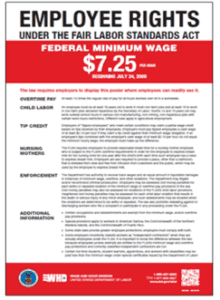Earlier this month, the United States Department of Labor (“DOL”) released a new poster to reflect recent amendments made to the Fair Labor Standards Act (“FLSA”) by the passage of the Providing Urgent Maternal Protections for Nursing Mothers (“PUMP”) Act. Under the amended FLSA, most employees who are nursing have the right to reasonable break times and a place, other than a bathroom, that is shielded from view and free from intrusion to breastfeed while at work.
The PUMP Act
On December 29, 2022, the PUMP Act was signed into law, further amending the FLSA to extend the reasonable break time and space protections to pump breast milk at work to as many as 9 million more employees who were not previously covered. These protections are available for up to one year after the child’s birth. In addition, the PUMP Act extended available remedies for violation of any provision of the pump at work requirements.
- Pumping During Break Time
An employer may not deny a covered employee a needed break to pump. The frequency, duration, and timing of breaks needed will vary depending on factors related to the nursing employee and the child. Factors such as the location of the space and the effort reasonably necessary to pump breast milk, e.g., the pump setup, can also affect the duration of the break an employee will need to pump.
The employee and employer may agree to a certain schedule based on the nursing employee’s need to pump, but an employer cannot require an employee to adhere to a fixed schedule that does not meet the employee’s need for break time to pump. Additionally, any agreed-upon schedule may need to be adjusted over time if the nursing employee’s pumping needs change. Employees who work remotely are also eligible to take pump breaks on the same basis as if they were working on-site.
- Space and Privacy Requirements
The FLSA requires that nursing employees have access to a place to pump breast milk at work that is:
- shielded from view;
- free from intrusion from coworkers and the public;
- available each time it is needed by the employee; and
- not a bathroom.
The location must be functional as a space for pumping and contain a place for the nursing employee to sit and a flat surface, other than the floor, on which to place the pump. Employers must ensure the employee’s privacy, for example, by displaying a sign when the space is in use or providing a lock for the door. Employees who are teleworking receive the same protections, including the right to take a pump break that is shielded from view.
- Protections Available and Enforcement
An employer who violates an employee’s right to reasonable break times and a private space to pump is liable for appropriate legal or equitable remedies under the FLSA. Remedies available to the employee may include reinstatement, promotion, lost wages, and an additional equal amount as liquidated damages, compensatory damages, economic losses that resulted from violations, and punitive damages where appropriate. These remedies are available regardless of whether the employee has experienced any retaliation for pumping at work.
To enforce the pump at work protections or retaliation provisions of the FLSA, an employee may file a complaint with Wage and Hour Division (“WHD”) of the DOL or may file a private cause of action seeking appropriate remedies. There is no waiting time or special procedure for an employee or other party to file a complaint with WHD alleging violations of any PUMP Act protections or to bring a private suit to enforce the reasonable break time requirement.
An employee can file a private suit regarding an employer’s failure to provide a space to pump, if the employee has notified the employer of the need for space and has allowed 10 days for the employer to come into compliance. The employee is not required to provide this notice if they were fired for requesting reasonable break time or space, if they were fired for opposing employer conduct related to FLSA pump at work rights, or where the employer has expressed a refusal to comply.
Updated Poster Requirements
The DOL published an updated FLSA poster in April 2023 that reflects current pump at work requirements:

This poster may be used to meet the FLSA posting requirement and is available for download here. Employers should ensure that they are posting this current version of the poster as the DOL has stated that the updated FLSA poster is mandatory. This means all employers subject to the FLSA (which is virtually every business or enterprise that has any employees, with a few limited exceptions) are required to display the recently revised version. Prior versions of the FLSA poster are no longer compliant and will not fulfill employers’ posting requirements, so it is important that they be replaced with the new version.
Other Recent and Upcoming Poster Requirement Changes
In October 2022 the Equal Employment Opportunity Commission (“EEOC”) released an updated “Know Your Rights: Workplace Discrimination is Illegal” poster that covered employers are required to display in the workplace. However, more changes are expected soon as the EEOC is expected to release a new notice in June 2023 to add additional information under the recently passed Pregnant Workers Fairness Act, which goes into effect June 27, 2023.
In April 2023, the DOL updated its “Your Employee Rights Under the Family and Medical Leave Act” poster. While the April 2016 and February 2013 versions remain compliant, as a best practice, employers should consider posting the most recent version as soon as possible to avoid any potential noncompliance issues.
The St. Louis employment attorneys at McMahon Berger have been representing employers across the country in labor and employment matters for over sixty years and are available to discuss these issues and others. As always, the foregoing is for informational purposes only and does not constitute legal advice regarding any particular situation as every situation must be evaluated on its own facts. The choice of a lawyer is an important decision and should not be based solely on advertisements.
